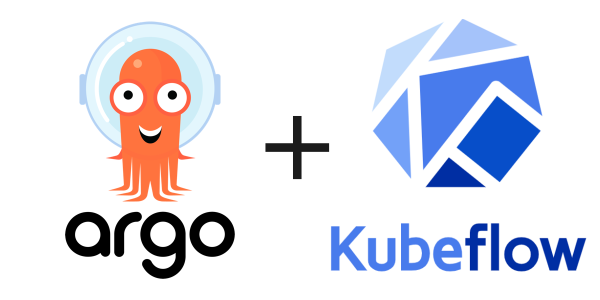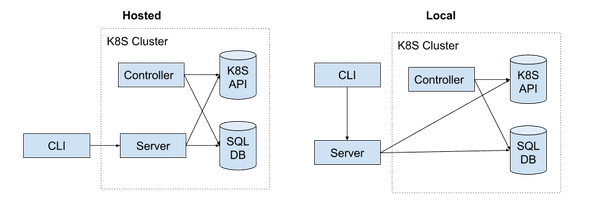
1.关于argo
Argo 项目是一组 Kubernetes 原生工具集合,用于运行和管理 Kubernetes 上的作业和应用程序。Argo 提供了一种在 Kubernetes 上创建工作和应用程序的三种计算模式 – 服务模式、工作流模式和基于事件的模式 – 的简单组合方式。Argo Workflow 的项目名称就是 Argo(https://github.com/argoproj/argo), 是 Argo 组织最初的项目。Argo Workflow 专注于 Kubernetes Native Workflow 设计,拥有声明式工作流机制,能够通过 CRD 的模式完全兼容 Kubernetes 集群,每个任务通过 Pod 的形式运行。
Workflow 基于k8s的开源流程控制引擎,为Kubernetes提供容器本机工作流。Argo工作流程中的每个步骤都定义为一个容器。通过 Kubernetes CRD(Custom Resource Definition)来进行实现的。提供 DAG 等依赖拓扑,并且能够通过 Workflow Template CRD 实现多个 Workflow 之间的组合与拼接。
与k8s的DSL方式类似,Argo 中的工作流自动化是通过使用 ADSL(Argo 领域特定语言)设计的 YAML 模板进行驱动的。ADSL 中提供的每条指令都被看作一段代码,并与代码仓库中的源码一起托管。Argo 支持6中不同的 YAML 结构:
- Container Templates(容器模板):creating a single container and parameters as required,创建单个容器模板
- Workflow Templates(工作流模板):defining a job, in other words short-running-app which runs to completion,创建工作流模板,每个工作流节点都被定义为一个单独的容器
- Policy Templates(策略模板): rules for triggering/invoking a job or a notification,触发或者调用作业/通知的规则
- Deployment Template(部署模板): create long running applications,创建一个长期运行的应用程序模板
- Fixture Templates(混合模板): glues third-party resources outside Argo,使用argo外部第三方的资源
- Project Templates(项目模板): workflow definitions that can be accessed in Argo catalog,可以在 Argo 目录中访问的工作流定义
2.argo的特点
1、argo是基于容器的,不需要传统的虚拟机机系统和环境 2、argo是云无关的,可以在任意的k8s集群中运行 3、argo能定制计算资源,让云端的资源在我们的掌握之中
3.argo架构模式设计
从v2.5开始,Argo支持“local”和“hosted”两种部署模式,v2.5之前只能是Hosted这种模式。
 argo workflow工作流
argo workflow工作流
 argo controller流程
argo controller流程

4.argo template
The Structure of Workflow Specs We now know enough about the basic components of a workflow spec to review its basic structure:(一个缩进的是必须包含,两个缩进的是非必须)
- Kubernetes header including metadata
- Spec body
- Entrypoint invocation with optionally arguments
- List of template definitions
- For each template definition
- Name of the template
- Optionally a list of inputs
- Optionally a list of outputs
- Container invocation (leaf template) or a list of steps
- For each step, a template invocation
以上一级均为必选向,二级为非必选项
To summarize, workflow specs are composed of a set of Argo templates where each template consists of an optional input section, an optional output section and either a container invocation or a list of steps where each step invokes another template.
Note that the container section of the workflow spec will accept the same options as the container section of a pod spec, including but not limited to environment variables, secrets, and volume mounts. Similarly, for volume claims and volumes.
argo模板中template代表可运行的节点,分为6类:
4.1)Container
该类型定义了我们一个容器运行的基础,会对应于我们在 kubernetes 中产生一个世纪的 pod,该实体的类型对应于标准 kubernetes 的 Container resource,kubernetes Container 具有的参数我们都可以在其中使用;
1
2
3
4
5
6
// 简单实例
name: sleep-n-sec
container:
image: alpine:latest
command: [sh, -c]
args: ["echo sleeping for seconds; sleep ; echo done"]
4.2)Script
该类型支持我们直接在 template 中定义并允许一段脚本,该 template 类型也是基于 Container 的,不过在 Container 的类型上面添加了一个 Source 字段来表示我们的脚本,我们在 Container 的运行配置中应该注释初始化我们脚本运行的环境;
1
2
3
4
5
6
7
8
9
// 简单实例
name: gen-number-list
script:
image: python:alpine3.6
command: [python]
source: |
import json
import sys
json.dump([i for i in range(20, 31)], sys.stdout)
4.3)Resource
该类型支持我们在 tempalte 中对 kubernetes 中资源操作的能力,我们可以 create, apply, delete, replace(对应该模板的action字段) k8s 中的资源;并且支持设定相关的成功与失败条件用于判断该 tempalte 的成功与失败;
1
2
3
4
5
6
7
8
9
10
11
12
13
14
15
16
17
18
19
20
21
22
23
24
25
26
27
28
29
// 简单实例
name: pi-tmpl
resource: #indicates that this is a resource template
action: create #can be any kubectl action (e.g. create, delete, apply, patch)
# The successCondition and failureCondition are optional expressions.
# If failureCondition is true, the step is considered failed.
# If successCondition is true, the step is considered successful.
# They use kubernetes label selection syntax and can be applied against any field
# of the resource (not just labels). Multiple AND conditions can be represented by comma
# delimited expressions.
# For more details: https://kubernetes.io/docs/concepts/overview/working-with-objects/labels/
successCondition: status.succeeded > 0
failureCondition: status.failed > 3
manifest: | #put your kubernetes spec here
apiVersion: batch/v1
kind: Job
metadata:
generateName: pi-job-
spec:
template:
metadata:
name: pi
spec:
containers:
- name: pi
image: perl
command: ["perl", "-Mbignum=bpi", "-wle", "print bpi(2000)"]
restartPolicy: Never
backoffLimit: 4
4.4)Suspend
该类型可以对我们的 Workflow 进行挂起操作,当我们运行到该类型的 template 时,我们的 Workflow 将会挂起,等待我们运行 argo resume {name} Workflow 才会继续运行下去;同时对于挂起操作,我们也可以直接运行 argo suspend {name} 来挂起某个 Workflow;
1
2
3
// 简单实例
name: suspend-test
suspend: {}
4.5)Steps
这类型可以指定我们的控制流,一般在其中会引用 tempalte 来进行基础单元进行工作。该类型可以让我们把 template 组合成一条 pipeline 来进行运行,并且在流程中还支持 tempalte 间参数的传递,条件的判断,递归调用…; 它使用一个二维数组来进行定义,在第一级数组串行运行,在第二级数组并行运行;
1
2
3
4
5
6
7
8
9
10
11
12
13
14
15
// 简单实例
name: coinflip
steps:
# flip a coin
- - name: flip-coin
template: flip-coin
# evaluate the result in parallel
- - name: heads
template: heads # 条件判断, 目前只支持 `==` 与 `!=`
when: " == heads"
- name: tails
template: coinflip # 递归调用
when: " == tails" # 条件判断
- name: heads1
template: heads
4.6)DAG
有向无环图,该类型可以定义我们的 DAG 类型 workflow, 在其中我们根据 依赖 来进行 DAG 的定制,没有 依赖 的 Task 将会作为 DAG 的 root 首先运行; 但是目前 DAG 中 Task 还不支持相关条件判断表达式来进行条件判断;
1
2
3
4
5
6
7
8
9
10
11
12
13
14
15
16
17
18
19
20
21
22
23
// 简单实例
name: multiroot
dag:
tasks:
- name: A
template: echo
arguments:
parameters: [{name: message, value: A}]
- name: B
dependencies:
template: echo
arguments:
parameters: [{name: message, value: B}]
- name: C
dependencies: [A]
template: echo
arguments:
parameters: [{name: message, value: C}]
- name: D
dependencies: [A, B]
template: echo
arguments:
parameters: [{name: message, value: D}]
在argo的每个step都会创建一个相应的pod执行

5.使用模板
argo cli方式
1
2
3
4
5
6
7
8
9
10
# 创建模板
argo template create https://raw.githubusercontent.com/argoproj/argo/master/examples/workflow-template/templates.yaml
# 提交模板
argo submit https://raw.githubusercontent.com/argoproj/argo/master/examples/workflow-template/hello-world.yam
# 指定namespace应用模板
argo submit --namespace argo https://raw.githubusercontent.com/argoproj/argo/master/examples/workflow-template/hello-world.yam
同时支持使用kubectl方式
1
2
3
4
5
6
# 创建模板
kubectl create -f https://raw.githubusercontent.com/argoproj/argo/master/examples/hello-world.yaml
# 指定namespace应用模板
kubectl apply -n argo -f https://raw.githubusercontent.com/argoproj/argo/master/examples/hello-world.yaml
argocli比kubecli提供更多的参数支持,例如模板传参
6.常用指令
1
2
3
4
5
6
7
8
9
10
11
12
13
14
15
16
# argo cli
argo submit hello-world.yaml # submit a workflow spec to Kubernetes
argo list # list current workflows
argo get hello-world-xxx # get info about a specific workflow
argo logs -w hello-world-xxx # get logs from all steps in a workflow
argo logs hello-world-xxx-yyy # get logs from a specific step in a workflow
argo delete hello-world-xxx # delete workflow
# kubectl
kubectl create -f hello-world.yaml
kubectl get wf
kubectl get wf hello-world-xxx
kubectl get po --selector=workflows.argoproj.io/workflow=hello-world-xxx --show-all # similar to argo
kubectl logs hello-world-xxx-yyy -c main
kubectl delete wf hello-world-xxx
7.关于argo ui
分析只用过程中没怎么用到,使用argo ui编辑流程配置也不是很方便,个人感觉没什么太大用处。
8.argo watch
argo查看workflow:argo –watch name
 也可以在submit时同步使用watch查看执行过程:
也可以在submit时同步使用watch查看执行过程:
1
argo submit --watch https://raw.githubusercontent.com/argoproj/argo/master/examples/hello-world.yaml